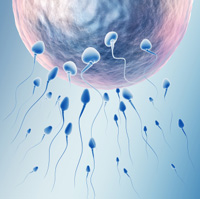Assisted Reproductive OptionsFertility Drugs
In females, fertility drugs promote ovulation by stimulating hormones in the brain to get one or more eggs ready and released in the ovaries each month. However, it is important to note, there is a higher chance of multiple births and a condition known as ovarian hyperstimulation syndrome (OHSS). Ovarian hyperstimulation syndrome (OHSS) is a serious side effect of some fertility drugs and is caused by the ovaries rapidly swelling due to the increased number of ripening eggs. SurgeryIn women, cervical, vaginal or endometrial abnormalities that prevent conception may be corrected surgically. Scar tissue, cysts, tumors, or adhesions, as well as blockages inside the fallopian tubes, may be surgically removed. The use of diagnostic techniques such as laparoscopy and hysteroscopy are also common.
In men, surgery may be required to remove any blockage in the vas deferens or epididymis, or repair a varicocele. A varicocele is an unnatural swelling of the veins in the scrotum. In Vitro Fertilization (IVF)This is a reproductive procedure in which a woman's eggs are removed from her body, fertilized with sperm in a laboratory, and then surgically implanted back into her uterus. In 1978, Louise Brown, the first ‘test-tube' baby was born in England, since that time thousands of babies have been conceived in this fashion. Intrauterine Insemination (IUI)Used to be called artificial insemination (AI) and this is where warmed prepared sperm is introduced into the woman's reproductive tract around the time of ovulation without intercourse, with the aim of getting the sperm nearer to the egg. IUI can help couples where the man has a low sperm count or motility, as long as there are sufficient levels of healthy sperm to make the treatment worthwhile. Additionally, the sperm can come from a sperm donor. Ejaculated sperm collected through masturbation, is then specially treated and washed, and the healthy sperm are extracted. Sperm can then be deposited in the vagina, cervix, uterus or fallopian tubes. This is a popular option for both heterosexual and homosexual couples. Intracytoplasmic Sperm Injection (ICSI)This is a procedure was first introduced in 1992 and was the most common form of infertility treatment used in Australia by 2005. A single sperm is injected directly into the egg by piercing the outer covering of the egg, and is particularly helpful for men who produce low numbers of sperm or whose sperm cannot move properly. Additionally it can help couples where the man has had an irreversible vasectomy, or has no sperm in his semen due to missing tubes or blockages in his reproductive organs. If a couple proceeds with ICSI, it should be remembered that these assisted reproductive technologies expose women to risk such as those associated with surgical collection of eggs, and switches the focus from the man to the woman. Donor SpermMale infertility is completely untreatable when the man has no sperm in his semen or in the testes, because the sperm producing cells in the testes either did not develop or have been permanently destroyed. The only option for such couples to achieve a pregnancy is to consider donor insemination. Donor Eggs & Embryo TransplantsSome women may not be able to produce healthy eggs due to ovarian failure or age-related infertility. For these women, egg (oocyte) and embryo donation have been successful. An embryo transplant involves artificial insemination of a donor's egg with the male partner's sperm. After fertilization has occurred, the embryo is transferred to the female partner's uterus. To be successful, it is imperative that fertility drugs be used to synchronize both women's menstrual cycles. The first baby conceived with a donor egg was born in Australia in 1983. Surrogate Parenting:For women who have healthy eggs, but cannot sustain a pregnancy to term, surrogate parenting is an option. The couple's sperm and egg are combined, and the zygote is implanted in another woman, called a gestational carrier. Women who can neither sustain a pregnancy not produce their own eggs may arrange to have another woman's eggs fertilized by the father's sperm. The woman who carries the foetus is called surrogate mother. At birth the child is then given to the noncarrying woman and her partner. Please contact your doctor for further details and specific medical advice and assistance in your case of infertility. Sperm CryopreservationSperm can be frozen and stored in liquid nitrogen for many years, this is called sperm cryopreservation. The sperm can be collected from the testis, epididymis, or from an ejaculation. The effectiveness of the sperm, once thawed, is variable, and sometimes the sperm do not survive the thawing process. Embryo CryopreservationEmbryo can be frozen and stored in liquid nitrogen for many years, this is called embryo cryopreservation. But again, like sperm, not all embryo's can survive the freezing and thawing process. The first baby developed from a frozen embryo was born in Australia in 1984. Other OptionsOther possibilities to have a family, if natural conception is not possible, may be:
Sex therapy and Relationship Counselling is available in Sydney, New South Wales (NSW) - Melbourne, Victoria (VIC) - Adalaide, South Australia (SA) - Perth, Western Australia (WA) - Darwin, Northern Territories (NT) - Hobart, Tasmania (TAS) - Brisbane, Queensland (QLD) - Canberra, Australian Capital territory (ACT) |
|
|
Copyright © 2010 - 2015 SS Bootstrap. All Rights Reserved. Web design by Sitesuite
TOP

 Sperm production and ovulation are a result of a well-balanced endocrine system (pituitary, hypothalamus, and gonads). However, some women and men have hormone irregularities that may interfere with the process of ovulation or sperm production. This is often the first step in treatment and many problems can be treated with fertility drugs, such as clomifene (Clomid) and gonadotrophins.
Sperm production and ovulation are a result of a well-balanced endocrine system (pituitary, hypothalamus, and gonads). However, some women and men have hormone irregularities that may interfere with the process of ovulation or sperm production. This is often the first step in treatment and many problems can be treated with fertility drugs, such as clomifene (Clomid) and gonadotrophins.
